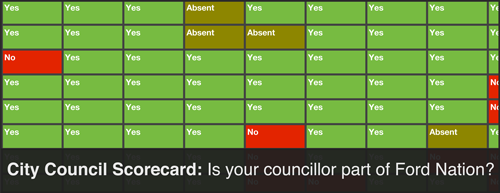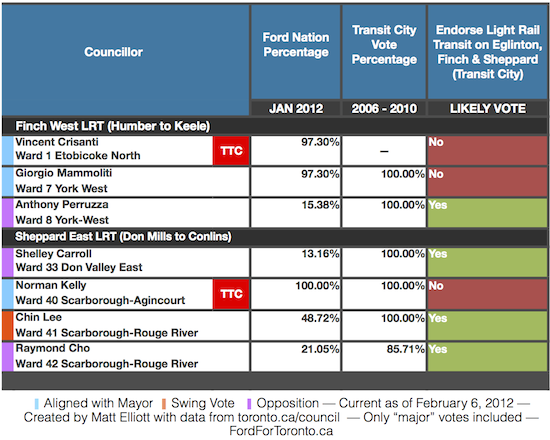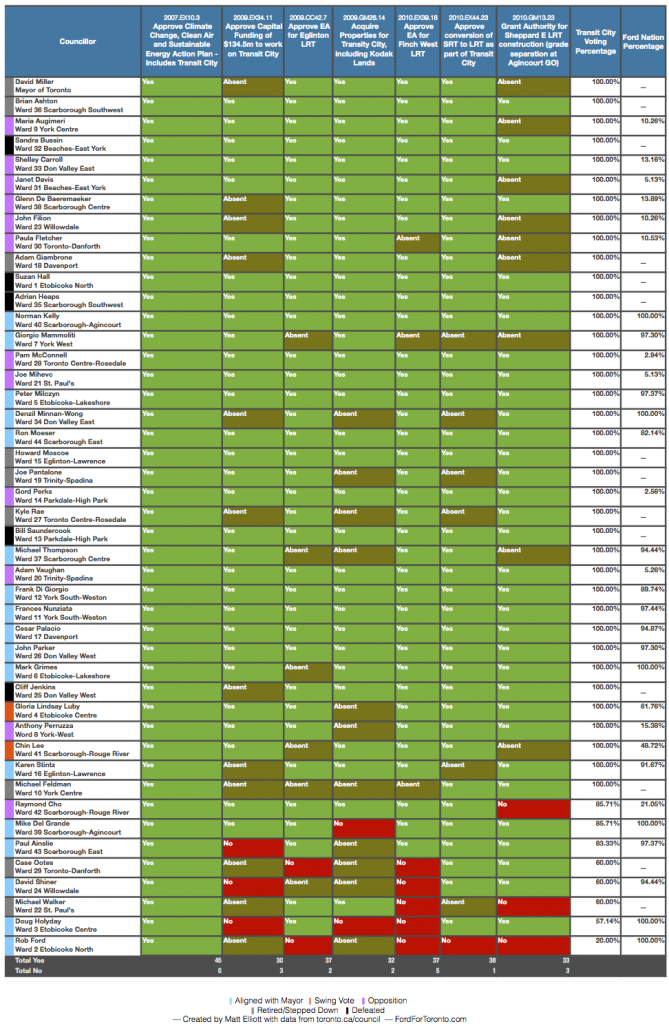On January 26, several days after TTC Karen Stintz mused openly about making substantial changes to current transit plans, Mayor Rob Ford made his first public statement on the subject. That statement was then quickly retracted because it was riddled with embarrassing factual errors, including a claim that the TTC had been building subways for 100 years. Toronto didn’t open its first subway line until 1954. The original message also claimed some degree of support for the underground plan by the Pembina Institute. To which Pembina quickly retorted: nope. (The original version, via Jonathan Goldsbie, is here.) On January 28, a revised version of the same message was posted to the mayor’s Facebook page. I decided to respond to it.
All quoted text via Rob Ford’s Weekly Report -Â week ending January 27, 2012.
Dear Friends,
Mr. Mayor! Hi. Sorry about how things have been going for you lately.
From 1910 to 2007, the City of Toronto has based its transit planning around subway lines (built or anticipated). It is now time that we get back to this sort of transit planning to make certain residents will continue to have rapid transit as a mode of commuting.
This is more historically accurate than your original claim that Toronto’s transit system has been based on subways for 100 years. But pointing to 1910 as the year the city started basing its transit planning around subway lines is still a little fishy. While a mayoral candidate that year did support subway construction, he was defeated. On New Year’s Day in 1912, the people of Toronto rejected the possibility of a Yonge subway line when it was put to ballot. The city didn’t get serious about subway construction until 1946.
It’d probably be more accurate to say that, historically, Toronto based its transit planning around streetcars. The TTC once operated a network of streetcar routes that crisscrossed the city, including very busy ones on corridors that later became part of Toronto’s subway system.
And it’s not like we’ve stopped looking at subways, either. There’s a subway extension to York University (and beyond!) currently in the works. And the Downtown Relief Line, which can only be heavy rail subway, is a critical infrastructure project for this city that deserves far more attention than it gets.
For the past 50 of those 100 years of planning transit around subways, the Yonge-University and Bloor-Danforth lines have continually served as arteries that take in thousands of people each day from near-by surface routes and get them to their destinations quickly.
No argument there. They’re great.
But just for the hell of it, here are some numbers you might find interesting: 714,000. 495,000. 48,000. 39,000. Those were, in 2010, ridership counts for the Yonge subway, the Bloor-Danforth subway, the Sheppard subway and the Scarborough RT respectively. The latter two figures are comparable with — and in some cases lower than — several bus and streetcar routes.
We are now at a juncture where we must expand on our established transit infrastructure to ensure people can continue getting to where they want to go in a fast and efficient way.
Great news! Glad that whole war on cars thing is over.
As you know, I have continually pushed for an underground LRT that will span from Jane/Black Creek to Kennedy Station. I have done this because residents have repeatedly stressed that they do not want streetcars that are marginally faster than busses and take up lanes of traffic. Lastly, it is important that Scarborough, the fastest growing region in Toronto, is finally provided with a rapid transit line that can help move its 625,000 residents faster.
Well, sort of. In your mayoral campaign, you pushed for no transit improvements on Eglinton at all. You told a crowd at a debate held at York Memorial Collegiate in September 2010 that the Sheppard Subway was “all we can afford.”
We’ll get to the speed of light rail transit (or ‘streetcars’ as you kind of derisively call them) later on, but let’s focus on the idea that you’re just doing what the people want you to do.
In a January 2011 Leger Marketing poll, taken at the height of your popularity, only one in four people believed that we should build subways because it’s what you promised during the election. One in four! Considering you won the election with just under half the popular vote, it’s probably reasonable to say that only about half of your base — of Ford Nation — saw your subways plan as an important driver of their support.
In the coming days you are likely to hear some comments from City Hall that will suggest we should go back to Transit City. Proponents will argue that Transit City is an effective way to get around Toronto. I argue, however, that the best way to move people across Toronto is with rapid transit – which you simply cannot have with the surface rail lines.
Sure you can. Speed is a function of design, not technology. Our subway system averages about 30 kilometres-per-hour across the whole system, but that figure is a lot lower if you look only at the downtown section, where stations are close together and the trains have to wait longer at stations due to crowding.
Similarly, speeds on the eastern part of Eglinton were designed to be a bit slower than they would have been on the western part, even though both were to be surface rail. In fact, the part of Eglinton that was to venture into Ford Country in Etobicoke was planned to run at speeds roughly equivalent to the Bloor-Danforth subway.
Metrolinx estimates that the average trip for a rider will be reduced by half on the underground Eglinton Crosstown. Scarborough transit riders on an underground line could travel from Laird Avenue to Kennedy Station in about 14 minutes. This is a vast improvement from the estimated travel time of 24 minutes on a surface rail line.
That feels a bit disingenuous. That section of the line had at least four more stops to service when it was on the surface. If speed is the priority, it’s well within your mandate as the mayor of Toronto to talk to Metrolinx about tweaks to the design that can achieve that. (By the way, here’s what’s decidedly not within your mandate: unilaterally deciding to spend $2 billion dollars to bury a section of rail track on Eglinton Avenue.)
And, even then: transit is inevitably about trade-offs. Does reducing travel times by ten minutes for some commuters justify leaving 50,000 riders on the Finch bus with no improved service?
It is also important to remember that an underground rapid transit line has considerable savings for taxpayers. Underground lines and the vehicles that travel on them require less maintenance since they are spared the wear and tear of Canadian summers and winters. This will result in infrastructure that lasts longer and keeps the capital replacement costs down.
Pretty sneaky, but I’m not sure this holds up. With underground transit, maintenance costs are mostly folded into operating expenses — after you or I take the last train home at night, the TTC lets loose with a phalanx of maintenance staff who work in the subway tunnels to keep things running smoothly on an ongoing basis. Our existing on-street rail, on the other hand, tends to be maintained through sporadic work paid for via the capital budget.
It’s hard to make direct comparisons between ongoing maintenance and operating costs and TTC budget data isn’t overly helpful in helping calculate costs.
Still, let’s look at an obvious cost advantage surface rail has over underground: when you run on the surface, you don’t need station infrastructure. This eliminates a number of ongoing expenses, including cleaning, security, building maintenance, heating & cooling, landscaping, and so on. A 2007 study that looked at station operating costs across 12 different transit systems (including Toronto’s), pegged the annual cost of a transit station at anywhere between $150,000 and $4.3 million. The median cost was about a million dollars.
But even ignoring station costs, let’s be charitable and say that putting all of Eglinton underground will save us $5 million per year over the long term. At that rate — ignoring interest — it would take only 400 years for your $2 billion investment to pay off.
The people of 2412 will thank you for your foresight. And then they’ll fly to work using their jetpacks.
Have a wonderful weekend!
Thanks. You too.
P.S. Hey, wait, isn’t it weird that, only a week ago, you were talking about how the city couldn’t afford to spend $5 million to keep bus routes operating and now you’re out in public arguing that we shouldn’t skimp on transit?
Just thought that was kind of funny. Anyway, take care.
P.P.S You have no chance in hell of winning a vote on this issue.






